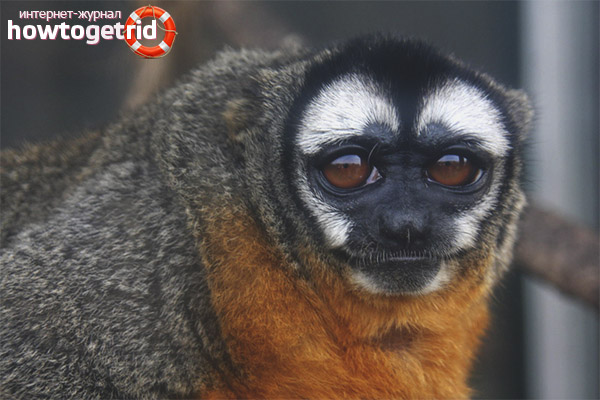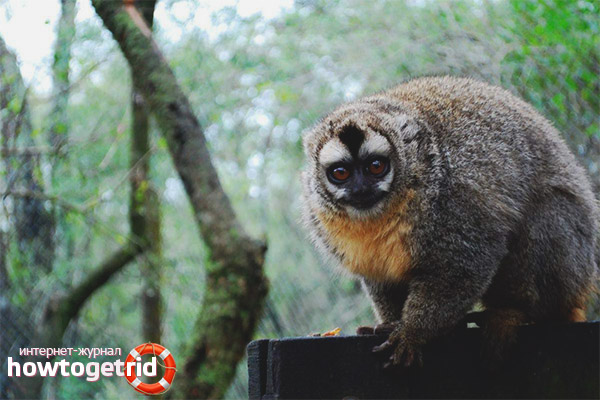The content of the article
What makes night monkeys not to sleep and hunt at night, and, moreover, travel long distances (about a kilometer), is not known for sure. There are many assumptions of scientists, but still these little brave travelers, despite the fact that they face many dangers, boldly leave their homes every night.
View description
Nocturnal monkeys have another official name - myrikins. They are quite miniature when compared with other primates. Body length - from 23 to 37 cm, and very small weight - does not exceed a kilogram.
These animals are very elegant, and during movement they look delightful because they grasp tenaciously at the branches, deftly throwing their subtle body.
The muzzle of the monkey is short, has a conical shape, the head is round. The eye sockets are very large, and therefore the eyes are also large, and the cornea is significantly curved, so it seems that the myrkins are always surprised to perceive everything around them. White rims around the eyes add this effect. Eye color is brown. Mirikins are well seen in the dark due to the special structure of the retina, however, their color perception is not so good.
The nasal openings from each other are at a very small distance. The ears are small, they are covered with thick hair. But on the face, hairs rarely grow. There are 36 teeth. Chewing teeth are very small, but the incisors are large, located vertically.
The tail is very long, can reach up to 40 cm. Hair covers it completely, the brush is black at the very tip. The coat is soft but fairly dense.
Color with olive and brown shades on the back and legs, but can be gray, silver, with black colors. The abdomen and paws on the inside are from light yellow to orange or gray. In many individuals, three longitudinal stripes are noticeable along the upper part of the head; gray stripes pass between them.
These monkeys have such a feature. They have an unusual throat air sac, an expanded trachea, which help to resonate the voice unusually. Because the voice is very loud. Scientists estimate that the sound range ranges from 190 to more than 1900 Hz. When a monkey makes various sounds, they are very reminiscent of the voice of a dog, cat and even a jaguar.
Habitat
Mirikins live only in areas where the climate is warm. This is South America and the central regions of North, where tropical deciduous and mixed forests grow. A prerequisite is that the vegetation be with a dense canopy and a large variety of trees. Both a dry and a humid climate are suitable for them; they also rise in the mountains, no higher than 2,500 m above sea level.
They are fed with leaves and fruits, as well as various insects, small birds and their chicks or eggs, small vertebrates. Moreover, they catch insects on the fly or collect from leaves. The sense of smell in myrikins is very developed, therefore they do not remain hungry. But they are often hunted by night predators - primarily owls and snakes.
Mini-monkeys can do without water for a long time due to the fact that they lick the dew and feed on very young sprouts.
Happy monkeys are hiding in hollow trees. These shelters above the ground are located very high - up to 10 m. Or live on the ground, but always in impenetrable thickets of epiphytes or vines, crevices of trees. As the sun sets, the nocturnal monkeys become energetic and active. Particular activity in them is manifested in the full moon.
These primates live in family groups, and even during hunting, they do not depart from each other by more than 10 m.
Procreation
In female nocturnal monkeys, pregnancy proceeds within 122 - 142 days, usually one baby is born. He is very small, weighs less than 100 grams, but already knows that you need to hold on to Mom’s belly. Soon, these responsibilities are fully assumed by the pope. After a month, the cub moves to his back, and the mother devotes the smallest part of the time to the baby - only for feeding, which lasts up to 7 months. However, at 4 months, the baby tastes plant foods. In their own family, the cub is allowed to live up to 2.5 years.











Submit